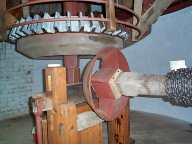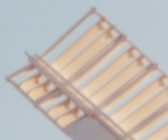Transnational Research Associates
An
Important Engineer
Andrew
Meikle, 1719-1811, Inventor of the “Spring Sail”
Art Madsen, M.Ed.
Part I
Conversion of Wind
to Mechanical Energy:
A Brief Overview
of Windmills and Wind Sails
Even before the Crusades in the 12th Century A.D., windmills not only fascinated the casual observer by their beauty and gracefulness, but were utilized to harness the wind and to perform, in a variety of ways, a broad cross-section of work related to pumping, grinding or threshing of grain. The conversion of wind energy, a plentiful and economical (indeed free) form of power, has been perfected in modern times to generate electricity and even to power certain types of turbine based methodologies and processes.
Along the developmental path of this reasonably primitive, but still fairly complex mechanical technology, there have been innumerable prominent inventors, millwrights and designers who have improved the centuries old structural features and characteristics of windmills. Strangely enough, the basic design of the windmill has remained constant – with the exception of the ultramodern “aeolian” devices that now serve on wind-farms worldwide for the production of electricity. This report, however, will exclude these generators, since they fall into another category, technically and conceptually, when contrasted with the classic windmill.
Historically, the windmill has been used throughout the centuries in Western European and North American nations to perform essential tasks. Pumping of large volumes of water was, and is, of extreme importance in The Netherlands, for example, and in agriculturally oriented countries. Windmills, on a massive scale, have performed the grinding of corn, wheat, barley and other grains for use in baked goods for more than 900 years. The advent of the steam engine ultimately rendered obsolete the windmill, but even after James Watt’s revolutionary invention, windmills remained prominent in England, France, Holland and Spain even after World War I. Today, they are largely sentimental relics restored by small groups of enthusiasts, mainly for their historical and aesthetic value.
From an engineering standpoint, the windmill is a complex device involving two to six blades. Models with eight blades have also been constructed. The blades or sails, as they are often called, are connected to a wind shaft, equipped with a brake wheel, and a meshing wallower wheel positioned at 90 degrees to the brake wheel. The transmission of energy, produced horizontally by the wind shaft, is reoriented vertically and, along a master shaft is transmitted down the full height of the tower to ground level where the energy can be used to grind or pump.
Figure One illustrates this concept in considerable detail. The particular windmill portrayed was designed to remove water from behind dykes in The Netherlands and is equipped with a crown wheel, a pit wheel, and bearings to transmit energy from the vertical master shaft to a huge scoop wheel (Beedell, 1975). Variations on this pattern are, of course, possible. The design of the classic internal mechanism shown in Figure One, below, evolved slowly over the centuries, with many usually anonymous inventors contributing to its improvement. Similarly, gradual evolution of other parts, such as external features, of the windmill also occurred.

Source: Beedell, 1975
Internal Wallower Mechanism of the Classic Windmill
Figure 1
However, in spite of these basically minor changes, the windmill remained intact until its uses and applications dictated more drastic changes, particularly in the efficiency with which its sails gathered wind for rotation of the huge drive shaft.
Turning now to the external features of the classic windmill, it is important to note that, initially, cloth was used for sail coverings. But soon it became obvious that, with gale strength winds, cloth could be torn and destroyed. Common sails, as the cloth variety were called, were useful and efficient under a fairly narrow range of weather conditions. One engineer, about whom this report will speak in detail, was ingenious enough to revolutionize the windmill’s wind gathering capability.
Part
II
Andrew
Meikle, 1719-1811, Engineer-Inventor of the Spring Sail
It
became necessary in order to control, insofar as possible, the regularity of
energy transmission to improve the huge sails, or blades collecting wind. In addition to providing a fan-tail to
rotate or pivot these blades into the wind, the rotating blades themselves had
to be improved.
Torry (1976, 60) describes the engineer who made this
possible, noting that he was even a colleague of James Watt, the engineer who
eventually put windmills “out of business.”
Andrew Meikle was an ingenious Scot who possessed many talents. He was a creative, mentally energetic man
whose interests in mechanical engineering spanned many specialties. After improving windmill sails in ways we
are about to describe, Meikle even invented the threshing machinery for
adaptation to the classic mill; he did so twelve years later in 1784 (Reynolds,
1970, 24).
Before branching off into threshing,
however, Andrew Meikle began to experiment with alternate sail designs. The hand-spreading of cloth over each frame
on huge blades had become burdensome and, as noted earlier, was inefficient
under high wind conditions. In 1772,
Meikle redesigned the entire sail frame.
He eliminated the use of cloth, and restructured the frame with
rectangular wooden shutters, which he arranged a bit like louvered
windows. Springs and levers, all
adjustable, controlled these shutter-like features. The springs he used in this effort were leaf and coil
springs. He worked hard on this
concept, as portrayed in Figure Two, below.
In 1780, Meikle further improved his revolutionary concept by adding a centrifugal control rod that essentially made allowances for the strength of the wind and opened the shutters in high velocity conditions, and closed them (for maximizing wind effect) under low wind conditions (Freese, 1972, 8). The cloth was also dropped into place automatically on his deluxe version of this invention, which he perfected in the
final stages of his career.

Source: Berry, 1999
Typical Spring Sail with Shutters
Figure 2
Meikle’s spring shutter concept, visible on Figure Two in the closed position, was immediately adopted in The Netherlands, France, England, and later in the United States.
The net effect of Meikle’s brilliant invention, even in its early stages, was to “spill the wind”, as he boasted, and allow the windmill to withstand the gale strength winds that often threatened it structurally (Reynolds, 1970, 92).
Modern millwrights, who still occasionally custom-build windmills in some countries for various purposes, owe a large debt to Andrew Meikle, an engineer often forgotten in the shadow of his contemporaries, like James Watt, because the overall efficiency of wind-gathering, energy transmission and the grinding or pumping activity thus produced was vastly improved. The cloth-equipped sail blades of the pre-Meikle era were still used under balmy conditions; and cloth sails were also sometimes in combination with the “spring sails” of Meikle. Obviously, windmills after this invention could churn and maintain productivity even in stormy weather.
Since Meikle’s day, of course, further improvements have
been made and wind power is now still harnessed by rotating blades, but it uses
technology and aerodynamic design features developed after World War II. Nevertheless, Meikle provided a valuable
link in our chain of knowledge in the field of aeolian energy.
Annotated Bibliography
Beedell, S. Windmills,
Scribner, New York, NY, 1975.
This
author provides a comprehensive and clearly written explanation of the internal
mechanism involved in converting wind-power to pumping energy. The Dutch windmill has become classic in
Western Civilization and is described in detail in this volume, along with
several other famous designs. Most of
the useful information for this report was derived from Beedell’s
well-organized book, along with supplemental material from Freese (1972).
Berry, M., Windmill World,
Suffolk Mills Group, Suffolk, UK, 1999. http://www.windmillworld.com/uk/suffolkmillsgroup.htm
This
website, updated periodically, seems to have been prepared by enthusiastic
lovers of windmills. It capitalizes on their photogenic appeal and provides
excellent geographic information on the location of still existing windmills
for those who wish to tour them. The
site concentrates heavily on the United Kingdom, but does include international
links and impressive lists of windmills, along with photos of them, still
standing in other nations. This is
largely a pictorial site, but has many insightful historical articles.
Freese, S. Windmills and Millwrighting, Great
Albion Books, So. Brunswick, U.K., 1972.
This
author is comprehensive in his treatment of windmills. Their history, design construction
techniques, purposes, internal mechanisms and operating personnel are all
referred to and elaborated upon. Ample
illustrations provide assistance for the reader and a fold-out diagram of a
Brill Windmill is especially impressive.
This book is excellent for exploring mechanical, historical and
pictorial aspects of many types of windmills.
Like several other books consulted, it is essentially a compilation and
does not, therefore, reach a uniform “conclusion” in the formal sense of the
term.
Reynolds, J. Windmills and
Watermills, Praeger, New York, NY, 1970.
This
is a large format volume containing in-depth chapters on development, design,
and improvement of windmills over the centuries. It explains actual internal machinery, as well as the uses of
various mills and offers information related to mill operational efficiency
under varying conditions. This is a
highly valuable and heavily pictorial volume containing a wide spectrum of data
useful to the professional researcher.
Torrey, V. Windcatchers: American Windmills of
Yesteryear and Tomorrow, Stephen Green Press, Brattleboro, VT, 1976.
Torrey
concentrates on American windmills dating back to the arrival of Europeans who
brought this technology with them in the 1600s and 1700s. He traces the various uses and styles of
American windmills right up to wind power devices used by ecologically
conscientious persons. There are
technical details as well as practical and informative descriptions. This well conceived volume is ideal for both
environmentalists and design or mechanical engineers.
Vince, J. Discovering
Windmills, Shire Publications Ltd., Aylesbury, Buck, U.K., 1973.
John
Vince has prepared a fascinating descriptive history of a wide range of
windmills in the U.K., many of which have been restored to operating
condition. This small volume, part of a
series, contains information about the sails and blades of various mills; it
also covers the superstructure and internal components of grain and grist
grinding mechanisms. Vince’s compilation
includes useful photos and is especially applicable to those researchers
interested in the history of these structures, as opposed to an engineer who
might prefer a more technical volume such as Beedell (1975), Freese (1972) or
Torrey (1976).